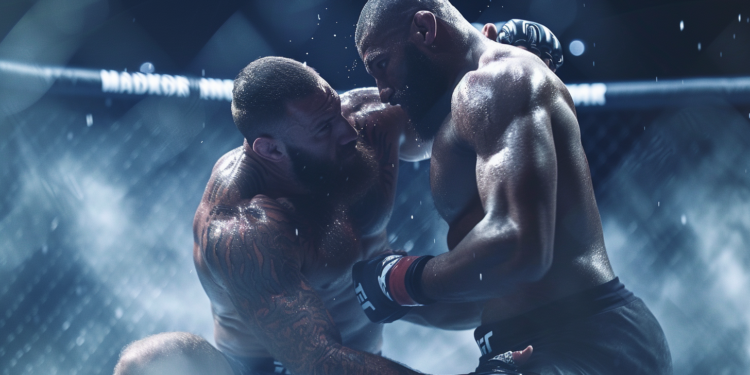You may be hesitant to delve into the world of MMA grappling, fearing it to be too complex or difficult to understand. However, fear not, as this discussion aims to demystify the ground game and provide you with a solid foundation of fundamental techniques.
From proper body positioning to essential submission holds and escapes, we will explore the key elements that will help you navigate the ground with confidence and control.
So, whether you are a beginner looking to gain a better understanding or an experienced practitioner wanting to refine your skills, this discussion will equip you with the knowledge and strategies needed to excel in the world of MMA grappling.
Key Takeaways
- Proper body positioning and control are essential for effective grappling in MMA.
- Mastery of basic grappling techniques and positions is crucial for establishing dominance on the ground.
- Understanding and proficiency in submission holds and escapes are imperative for success in MMA grappling.
- Strategic ground control strategies, along with strength and conditioning, are key factors in achieving grappling success in MMA.
The Importance of Proper Body Positioning
Proper body positioning is crucial in MMA grappling, as it enables you to effectively control your opponent and execute techniques with maximum efficiency. To achieve this, understanding the importance of leverage and weight distribution is paramount.
By utilizing leverage, you can manipulate your opponent's body in a way that makes it difficult for them to escape or counter your moves. This involves positioning your body in a way that maximizes your strength while minimizing theirs.
Weight distribution plays a crucial role in maintaining balance and stability during grappling exchanges. By distributing your weight properly, you can control your opponent's movements and limit their options. For example, shifting your weight to one side can make it harder for your opponent to escape or mount an effective offense.
Another key aspect of proper body positioning is utilizing angles for optimal body control. By angling your body in relation to your opponent, you can gain a positional advantage. This can be achieved by circling around your opponent or changing the angle of attack. By doing so, you can create openings for submissions or takedowns while minimizing the risk of being countered.
Basic Grappling Techniques and Positions
To effectively execute grappling techniques in MMA, it's essential to understand and master the basic positions and techniques. This includes proficiency in takedowns and takedown defense, as well as guard passing and maintaining top position.
Takedowns are crucial in establishing dominance on the ground. They allow you to bring your opponent down to the mat, where you can control and submit them. Common takedowns include the double leg takedown, single leg takedown, and hip toss. It's important to have a solid base and maintain proper balance and leverage during takedowns to ensure success.
Equally important is takedown defense. This skill allows you to prevent your opponent from taking you down and maintain your standing position. Effective takedown defense involves sprawling, sprawling and brawling, and utilizing underhooks to neutralize your opponent's takedown attempts.
Once the fight goes to the ground, guard passing becomes a key technique. Guard passing refers to moving past your opponent's legs to achieve a dominant position. This can be done through techniques such as the knee cut pass, stack pass, and leg drag. Maintaining top position is crucial as it allows you to control your opponent, land strikes, and set up submissions.
Mastering these basic grappling techniques and positions will provide a solid foundation for success in MMA. Practice diligently and pay attention to details, and you'll be on your way to becoming a formidable grappler in the cage.
Essential Submission Holds and Escapes
After establishing a dominant position on the ground through effective guard passing and maintaining top control, it's imperative to possess a repertoire of essential submission holds and escapes in order to secure victory in MMA.
Chokes and joint locks: mastering the art of submission.
When it comes to submission holds, chokes and joint locks are the bread and butter of MMA grappling. Mastering these techniques is crucial for gaining the upper hand in a fight. Whether it's a rear-naked choke or an armbar, understanding the mechanics and execution of these submissions can make all the difference in securing a win.
Escaping dangerous situations: techniques for getting out of tight spots.
In MMA, finding yourself in a dangerous position can be a game-changer. Being able to escape these tight spots is essential for survival. Techniques such as bridging, shrimping, and creating space are fundamental for escaping from under an opponent's dominant control. By mastering these escapes, you can turn the tide of the fight and regain control.
Strategies for Effective Ground Control
In order to establish and maintain effective ground control in MMA, it's essential to employ strategic positioning and constant pressure on your opponent. Transitioning between positions is a key aspect of ground control. It allows you to neutralize your opponent's movements and maintain dominance. To successfully transition, you must anticipate your opponent's reactions and have a clear understanding of the various positions and their advantages. Utilize your knowledge to seamlessly move between positions, ensuring that you always have the upper hand.
Maintaining control in scrambles is another crucial element of ground control. When both you and your opponent are actively fighting for advantageous positions, it's essential to stay composed and focused. Keep your weight centered and utilize your limbs as anchors to prevent your opponent from escaping or gaining the upper hand. By exerting constant pressure and maintaining a strong base, you can effectively control the scramble and dictate the flow of the fight.
Developing Strength and Conditioning for Grappling Success

Developing strength and conditioning is essential for achieving grappling success in MMA. To excel in the ground game, you need to focus on building a solid foundation of physical fitness. Here are three key factors to consider:
- Injury prevention: Grappling puts immense strain on your body, making injury prevention crucial. Incorporate exercises that target the muscles and joints used during grappling, such as the hips, shoulders, and core. Strengthening these areas will enhance stability and reduce the risk of injury.
- Nutrition for optimal performance: Fueling your body with the right nutrients is vital for peak performance in grappling. A balanced diet rich in lean proteins, healthy fats, and complex carbohydrates will provide the energy needed during intense training sessions. Additionally, staying hydrated is essential to maintain optimal performance and aid in recovery.
- Periodization and progressive overload: To continually improve your grappling abilities, you must implement a structured training program. Utilize periodization techniques by cycling through different phases of training, focusing on strength, endurance, and power. Additionally, gradually increase the intensity and volume of your workouts to ensure progressive overload and prevent plateaus.
Frequently Asked Questions
What Are Some Common Mistakes to Avoid When It Comes to Body Positioning in MMA Grappling?
When it comes to body positioning in MMA grappling, common mistakes to avoid include poor hip control, which can lead to being taken down easily. Improving takedowns and defending against them requires precise technique and experience.
How Can I Improve My Takedowns and Takedown Defense in MMA Grappling?
To improve your takedowns and takedown defense in MMA grappling, focus on proper footwork, timing, and technique. Mastering the double leg and single leg takedowns, as well as sprawls and underhooks, will give you a solid foundation in this aspect of the game.
Are There Any Specific Submission Holds That Are More Effective in Certain Positions?
When considering the top vs. bottom position in MMA grappling, it's important to note that each offers different submission opportunities. While joint locks can be effective in certain positions, chokes tend to be more effective overall.
What Are Some Effective Strategies for Maintaining Control on the Ground in MMA Grappling?
To maintain control on the ground in MMA grappling, focus on effective strategies. Avoid common mistakes in body positioning, work on improving takedowns and takedown defense, learn effective submission holds in specific positions, and enhance strength and conditioning.
How Can I Improve My Overall Strength and Conditioning Specifically for MMA Grappling?
To improve your overall strength and conditioning for MMA grappling, focus on nutrition for optimal fueling and recovery. Incorporate plyometric training to enhance explosive power and agility, crucial for takedowns, escapes, and transitions on the ground.
Conclusion
Congratulations, young grappler, for delving into the intricate world of MMA grappling fundamentals. Like a skilled artist wielding a brush, you have learned the importance of body positioning, mastered basic techniques and positions, and discovered the power of submission holds and escapes.
With unwavering dedication, your ground control strategies have evolved into a symphony of precision. As you continue to strengthen your body and conditioning, remember that the ground game is a canvas waiting to be conquered.
Embrace the art of grappling and let your skills shine brightly in the arena.












